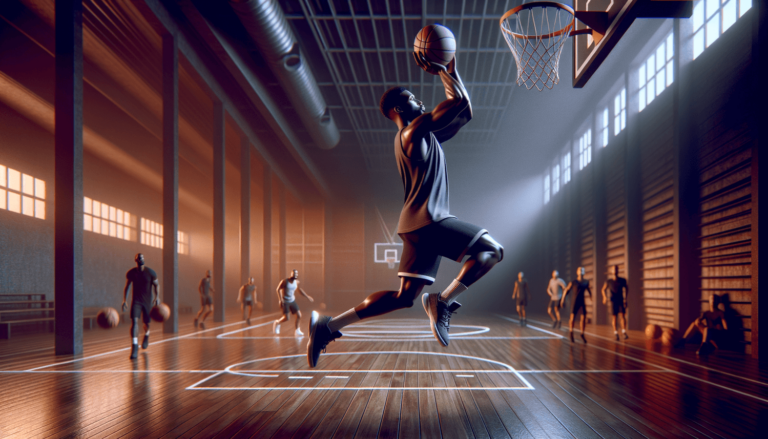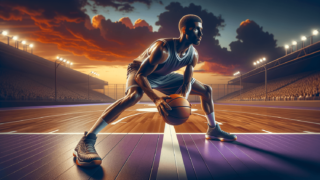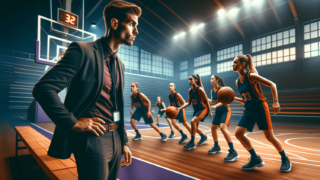
How to Develop a Consistent Shooting Stroke in Basketball?
Written by: Basketball Universe
Last updated:

Welcome to a fascinating deep dive into the world of basketball shooting! Achieving a consistent shooting stroke is crucial for players striving to improve their overall game and unlock their full potential. In this expert guide, we’ll take you through the key principles and techniques that you need to master to become a reliable scoring threat on the court. By combining fun and engaging anecdotes with clear, professional advice, we’ll set you up with all the tools and knowledge necessary to develop a smooth, efficient, and unstoppable shooting stroke. Get ready to level up your hoop skills – let’s get started!
How to Develop a Consistent Shooting Stroke in Basketball?
Developing a consistent shooting stroke requires focusing on proper mechanics, regular practice, and mental conditioning. Key aspects are establishing a solid base and balance, aligning your shooting arm and elbow, gripping the ball correctly, developing a fluid release, and following through. Dedicate time to repetition and form shooting drills, keeping a positive mindset, and analyzing and adjusting your technique accordingly. Practicing under diverse game-like conditions can help you build confidence and maintain consistency during actual games.
Mastering the Art of Proper Mechanics
Getting the basics right is the first step to developing a consistent shooting stroke. Understanding the proper mechanics and fundamentals of shooting helps build muscle memory and consistency. Let’s discuss the essential components of a great shot.
1. Stance and Balance
A solid foundation begins with your stance and balance. Stand with your feet shoulder-width apart, slightly staggered with your shooting foot slightly forward. This helps establish a comfortable base and sets you up for an accurate, high-percentage shot. Slightly bending your knees will enable you to absorb force and generate power without sacrificing control.
2. Shooting Hand Position
Your shooting hand should be positioned on the ball with your fingers spaced out and comfortably resting on its surface, while your thumb and little finger form a “Y.” Your non-shooting hand, also known as the “guide hand,” should rest on the side of the ball, without applying pressure or influencing the shot. This hand is meant to keep the ball steady and aligned as you initiate your shooting motion.
3. Elbow and Arm Alignment
Proper alignment of your shooting arm and elbow is another crucial factor. Your shooting arm should form an “L” shape, with your elbow directly below the wrist and aligned with your knee. This positioning ensures a straight and consistent shot path towards the basket.
4. Shot Pocket and Release
When preparing to shoot, bring the basketball up to your ‘shot pocket’ – the area just above your forehead, where you feel most comfortable and controlled. Additionally, a quick and fluid release will make your shot more difficult for defenders to block, while also improving your shot consistency.
5. Follow Through
Lastly, a proper follow-through technique is essential. Extend your shooting arm fully and “flick” your wrist, creating a swan-like neck effect. This motion imparts the necessary backspin on the ball for maximum accuracy and a soft touch on the rim, increasing the likelihood of successful shots.
Practice, Practice, Practice: Shooting Drills and Repetition
Once you have understood and mastered the mechanics of shooting, it’s time to put them into practice. Building a consistent shooting stroke in basketball is heavily reliant on repetition and muscle memory. By incorporating a variety of shooting drills and exercises into your practice regimen, you can strengthen your shot’s overall consistency.
1. Form Shooting Drills
Form shooting drills focus on progressing from simple to complex shot scenarios. Start by practicing one-handed shots close to the basket, focusing on maintaining proper form throughout the shooting process. Gradually move further away from the hoop while combining both hands, then progress to more complex, game-like conditions.
2. Catch and Shoot Drills
Catching and shooting quickly is vital in a proper basketball setting. Training your body to catch and shoot with appropriate form will ensure a smoother transition from receiving the ball to releasing it. Incorporate drills that involve catching passes and shooting from various angles and distances. Remember, variety is the key to success here and will help you develop a robust and consistent shooting stroke.
3. One-Dribble Pull-Up Drills
Pull-up jump shots off a dribble require speed, agility, and perfect timing. Practicing this skill helps you to integrate your shooting mechanics with quick decision-making and movement. Perform one-dribble pull-up drills at various angles and distances from the basket, simulating potential game scenarios to build your shooting stroke consistency.
Building Mental Toughness
Achieving a consistent shooting stroke goes beyond physical practice; it involves developing mental toughness and confidence. In basketball, having the right mindset can have a significant impact on your shot-making ability.
1. Visualization Techniques
Visualization is a powerful mental exercise that can help build confidence and foster a more relaxed approach during games. Visualize yourself making shots in various game situations and overcoming obstacles like defenders or pressure. Practicing these mental images will make it easier to perform under actual game conditions.
2. Positive Self-Talk
Boost your confidence and attitude by engaging in positive self-talk. Remind yourself of the work you’ve put in during practice and the progress you’ve made. Transform negative thoughts into positive ones to help you maintain your focus on the court.
3. Establish a Pre-Shot Routine
Many professional basketball players have pre-shot routines that help them mentally prepare for executing a shot. This ritual can be as simple as taking a deep breath or dribbling the ball a few times before shooting. Developing and practicing a consistent pre-shot routine can lead to improved focus and comfort during actual games.
Analyzing and Adjusting Your Technique
As you work on your shooting stroke, it’s crucial to evaluate your progress regularly. Analyzing and adjusting your technique will help you fine-tune aspects of your mechanics and address any issues that might be affecting your shot.
1. Record Your Shooting Sessions
Video recording your shooting sessions enables you to see your form from different angles and identify areas for improvement. Review the footage with a coach or an experienced player who can provide valuable insights and guidance. You can also compare your shot to professional players to spot similarities and differences in their mechanics.
2. Use Data to Track Progress
Track your shooting performance with essential shooting data, such as field goal percentage, free throw percentage, and three-point shooting percentage. This information will allow you to identify trends, monitor your progress, and set measurable goals for improvement in specific areas. You can also compare your stats to those of successful basketball players to get a better perspective on your performance.
3. Incorporate Feedback and Adjustments
As you analyze your shooting technique, incorporate the feedback provided by coaches, teammates, or fellow players. Make small, incremental adjustments and practice with the new changes, monitoring your progress and making necessary alterations until you find a comfortable and consistent shooting stroke.
In conclusion, developing a consistent shooting stroke in basketball requires dedication, patience, and a commitment to continuous improvement. By mastering shooting mechanics, practicing regularly with a variety of drills, honing mental toughness, and analyzing and adjusting your technique, you’ll eventually master the art of consistent shot-making and become a more confident and efficient basketball player.
Mastering Advanced Shooting Techniques
Once you have a solid foundation in shooting mechanics and technique, it’s time to refine your skills and add advanced shooting techniques to your arsenal. Focusing on these advanced elements can provide additional benefits to your overall scoring ability and consistency.
1. Step-Back Jumpers
Step-Back Jumpers are an excellent tool to create separation from defenders and get an open shot. Start by driving towards the basket, plant your foot, and quickly step back to transition into a shooting position. Be sure to maintain your balance and shooting mechanics during this complex movement.
2. Turnaround Jump Shots
Turnaround jump shots are an effective method for scoring in the post or against taller defenders. Receive the ball with your back to the basket, make a quick pivot, and immediately rise into your jump shot. Practice different pivoting techniques and varying degrees of turn to build skill and expand your offensive repertoire.
3. Running Floaters
Running floaters aid in scoring over taller players or shot blockers. Drive towards the hoop, jump off one foot, and release a high-arcing floater using your shooting hand. Focus on developing a soft touch to maximize your chances of scoring with this difficult shot.
Strength and Conditioning for Enhanced Shooting Performance
Physical fitness is vital when developing a consistent shooting stroke. Targeting specific muscle groups and incorporating cardio conditioning into your training regimen can have a significant positive impact on your shooting performance.
1. Upper-Body Strength Exercises
Focus on strengthening your shoulders, arms, and wrists: these muscle groups are essential for controlling your shot and maintaining proper form. Exercises such as push-ups, pull-ups, tricep dips, and wrist curls can help you build strength and stability in your upper body.
2. Core Strength
A strong core ensures proper balance and stability during the shooting process. Planks, Russian twists, leg raises, and other core-strengthening exercises can help improve your overall balance and performance on the court.
3. Lower-Body Strength and Agility
Your legs generate power for your shot and are crucial for jumping and quick movements. Squats, lunges, and plyometric exercises can increase lower-body strength, while agility exercises like footwork drills and ladder runs will improve your foot-speed, allowing you to get into better shooting positions.
4. Cardio Conditioning
Cardio fitness enables you to maintain a high level of intensity and endure long periods of play, essential for maintaining your shooting consistency throughout a game. Incorporate running, swimming, cycling, or other cardiovascular activities into your training regimen to build stamina and endurance.
Basketball Shooting Competitions and Games
Fun, competitive games and activities can help you improve your shooting stroke in a low-pressure environment. Participating in games and competitions that emphasize shooting skills promotes both skill and confidence development.
1. HORSE
HORSE is a classic basketball shooting game where players take turns shooting from different locations on the court. The objective is to replicate your opponent’s made shots, avoiding receiving a letter from the word “HORSE.” This game helps players practice various types of shots from various positions on the court.
2. Around the World
Around the World is a shooting competition that helps players practice shots from multiple spots on the court. Players take turns attempting shots from various designated positions, with the ultimate goal of making a shot from each location before returning to the starting point. This game allows you to practice shooting consistency under competitive, low-pressure conditions.
3. 21
21 is a fast-paced, informal basketball game that focuses on individual scoring. Players earn points through field goals and free throw shots while simultaneously playing defense against the other participants. Playing 21 can help you develop your shooting stroke and shot selection while incorporating live-game situations and defensive pressure.
By incorporating these advanced shooting techniques, strength and conditioning elements, and engaging in competitive games, you can continue to develop and refine your shooting stroke. These additions to your training regimen will help take your basketball shooting skills to new heights, enabling you to achieve greater success and enjoyment on the court.
FAQ Section: Developing a Consistent Shooting Stroke
Here we address common questions regarding the development of a consistent shooting stroke in basketball. Dive into these frequently asked questions to clarify doubts and help you on your journey to becoming a better shooter.
1. How long does it take to develop a consistent shooting stroke?
The time required to develop a consistent shooting stroke varies from player to player. It depends on factors such as your current skill level, practice frequency, and dedication to perfecting your shooting mechanics. Progressing gradually and consistently practicing the techniques can lead to significant improvements over time.
2. What is the ideal shooting release point?
An ideal shooting release point is above your forehead, with the ball slightly in front of and above your dominant eye. This position allows for optimal alignment, control, and consistency in your shot. However, this might vary depending on personal comfort and style.
3. How can I increase my shooting range?
To increase your shooting range, focus on building strength in your legs, core, and upper body, as these muscle groups contribute to generating power for your shot. Additionally, work on refining your shooting mechanics and practice shooting from incrementally increasing distances to gradually build your range.
4. Can a shooting coach help improve my shooting stroke?
Yes, working with a shooting coach can provide valuable insights and tailored guidance to improve your shooting stroke. Coaches can assess your mechanics, help identify weaknesses, and suggest corrective measures, personalized drills, and practice routines to enhance your shooting performance.
5. Should I change my shooting form if I’m already comfortable with it?
If your current shooting form works well for you, it may not be necessary to make drastic changes. However, if you face inconsistencies or feel that your form is limiting your performance, consider seeking professional advice and making adjustments based on expert feedback.
6. How can I practice shooting under pressure?
Simulate game-like conditions and introduce stressors during your practice sessions to build your ability to perform under pressure. This can include practicing shots with a defender, adding time constraints or shot clocks, and participating in competitive shooting drills or games.
7. What are some tips for shooting a basketball higher?
To shoot a basketball higher, ensure proper leg strength and generate enough force during your jump. Adjust the angle of your shooting arc and focus on a higher release point above your head. Experiment with different shooting motions and arc heights to find what works best for you.
8. How can I improve my shooting accuracy?
Improving shooting accuracy involves perfecting your shooting mechanics and form, practicing consistently with a range of shooting drills, and focusing on targeted muscle groups through strength training. Additionally, work on mental conditioning techniques like visualization and positive self-talk to boost confidence and performance.
9. Should I focus more on technique or repetitions when practicing my shooting?
Both technique and repetitions are crucial to developing a consistent shooting stroke. Initially, focus on acquiring proper shooting mechanics and form, then transition to repetitive practice with drills and game-like simulations to reinforce muscle memory and optimize performance.
10. How can I prevent my shooting form from deteriorating during games?
Maintaining your shooting form during games requires working on your conditioning, both physical and mental, and regularly practicing shooting mechanics to build muscle memory. Train under game-like conditions, develop a pre-shot routine, and focus on staying relaxed and confident to enhance your on-court shooting performance.
Featured Posts
- No pillar pages found.





